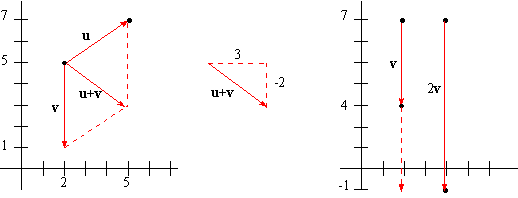Part 3: Vector Arithmetic
The parallelogram law (which we prove in the exercises) says that the
sum u+v is the main diagonal of the parallelogram formed by u and v. In addition,
the difference of 2 vectors is
|
u - v =
á u1-v1,u2-v2,u3-v3
ñ |
|
which corresponds to the off-diagonal of the parallelogram defined by
u and v.

If u = kv for some nonzero scalar k, then u and v are said to be scalar multiples of each
other. Geometrically, if u and v are scalar multiples
of each other, then u and v are said to be parallel.
EXAMPLE 6 Find u+v and 2v when u =
á 3,2
ñ and v =
á0,-4
ñ
Solution: Their sum is given by
|
u+v =
á 3,2
ñ +
á 0,-4
ñ =
á 3+0,2-4
ñ =
á 3,-2
ñ |
|
Moreover, multiplication of v =
á 0,-4
ñ by
the scalar 2 yields
|
2v = 2
á 0,-4
ñ =
á 0,-8
ñ |
|
The sum and scalar multiplication are shown geometrically below:

The 0 vector is defined 0 =
á 0,0,0
ñ . It is shown in the exercises that the arithmetic
of vectors has the following properties:
Theorem 1.1: If u, v, w are
vectors and if k, m are scalars, then
The properties in Theorem 1.1 and the concepts of magnitude and direction
allow vectors to be used in many different applications.
EXAMPLE 7
An airplane heads due east at 200 mph
through a crosswind blowing due north at 30 mph. The superposition
(i.e., sum) of these two velocities is the airplane's actual velocity
vector. What is the airplane's actual speed and direction?
Solution: The heading velocity vector is
á200,0
ñ and the wind velocity vector is
á0,30
ñ . Thus, the actual veclocity of the airplane is
|
v =
á 200,0
ñ +
á 0,30
ñ =
á 200, 30
ñ |
|
which is the main diagonal of the parallelogram (in this case, a rectangle) formed by the heading and wind vectors.
The airplane's actual speed is the magnitude of v:
|
||v|| = |
 |
|
|
2002 + 302 |
|
= 202.24 mph |
|
|
The actual direction can be found from the fact that ||v|| cos(a) = a, which in
our case yields
|
202.24 cos(a) = 200, or a = cos-1 |
æ
ç
è
|
|
|
ö
÷
ø
|
= 0.588 radians |
|
This is about a = 0.14897( 180/p) = 8.5354° north of due east.
In general, a vector is an element of a Vector Space, where a Vector Space is
a set with addition and scalar multiplication operations satisfying (1) - (7) in
theorem 1.1. For example, R3 is the vector space of all
possible 3-dimensional vectors, and a given vector v
= áa,b,cñ
is an element in the vector space R3.
Check your Reading: Is 2v the
same as v+v ? Explain.


